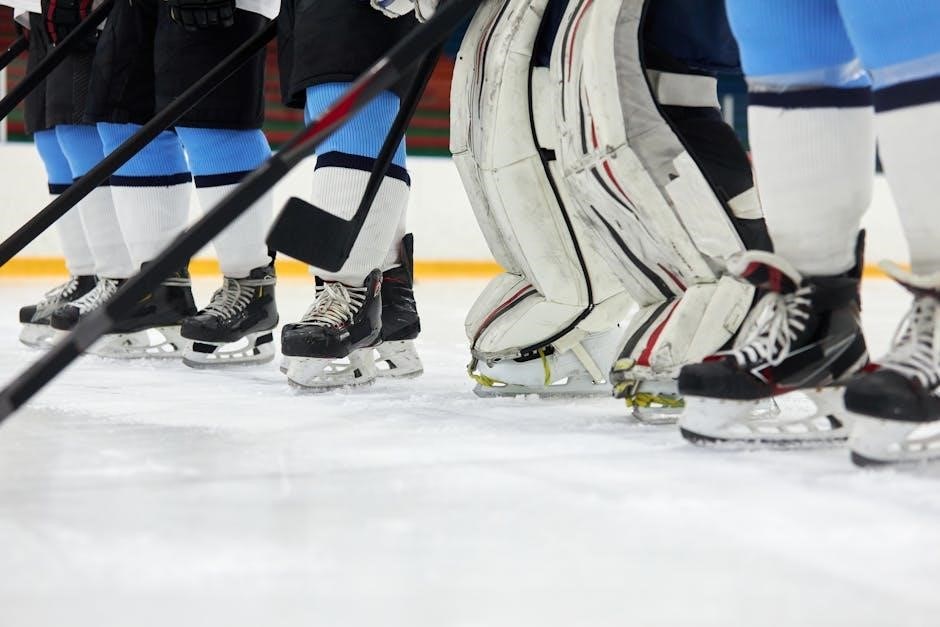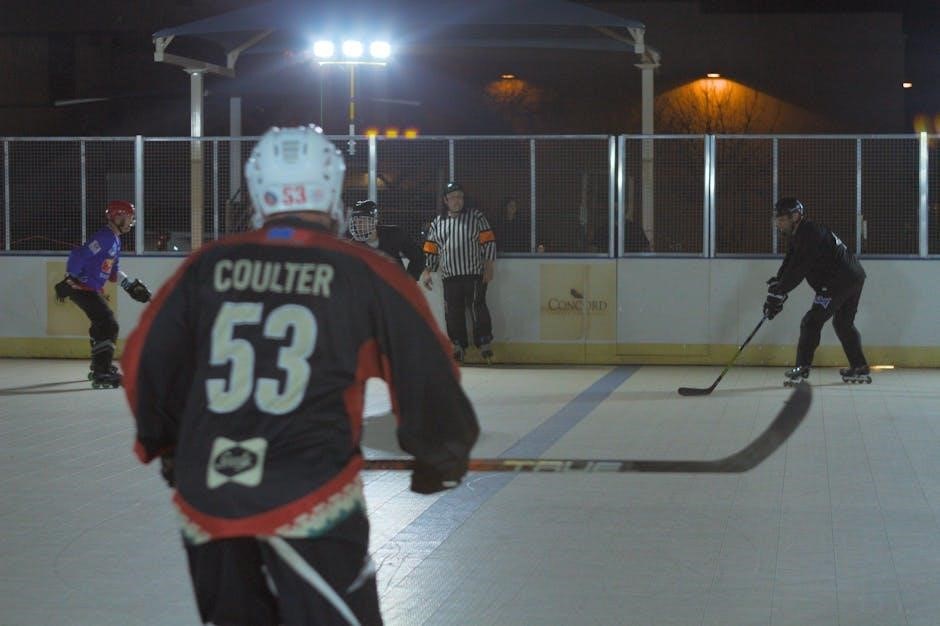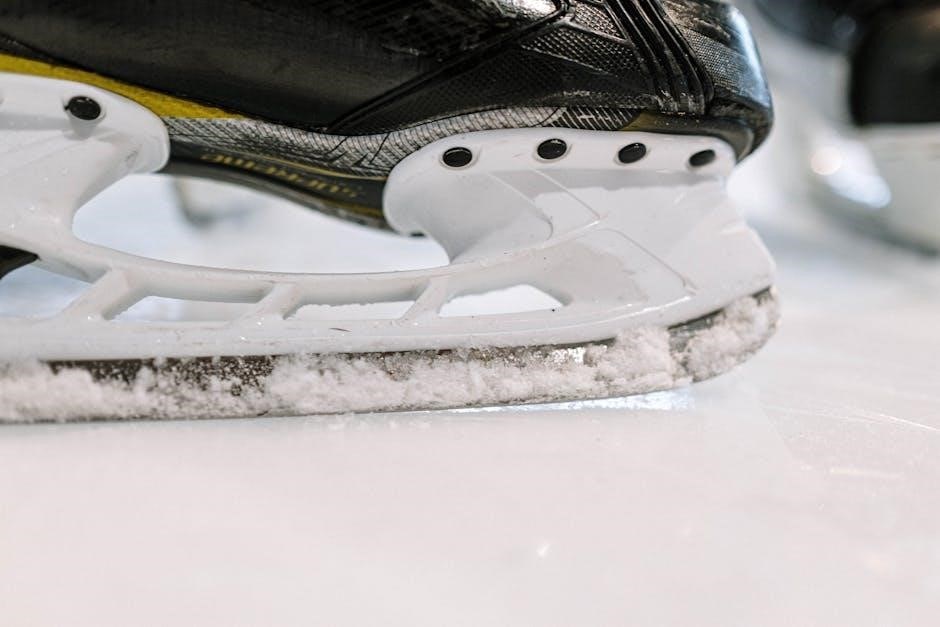Referee signals in hockey are crucial for gameplay, with
- official hand signals
and
specific penalty signals
used to maintain order and fairness, as outlined in various hockey referee signals pdf guides online always․
Importance of Referee Signals in Hockey
Referee signals play a vital role in maintaining the flow and integrity of hockey games, as evident from various hockey referee signals pdf guides available online․
The use of standardized signals helps to ensure that players, coaches, and spectators are aware of the decisions made by referees during the game․
This clarity is essential for preventing misunderstandings and disputes that could arise from unclear or ambiguous calls․
By using a consistent set of signals, referees can effectively communicate their decisions to all parties involved, promoting a fair and enjoyable game․
The importance of referee signals in hockey cannot be overstated, as they are a crucial component of the game’s infrastructure․
Effective communication is key to the success of any team sport, and referee signals are a fundamental aspect of this communication in hockey․
As such, it is essential for referees to be well-versed in the official hand signals and to use them consistently throughout the game․
This consistency helps to build trust and credibility with the players and coaches, which is essential for maintaining a positive and respectful game environment․
Overall, the use of referee signals is a critical aspect of hockey, and their importance should not be underestimated․
Referees must be knowledgeable about the signals and use them correctly to ensure a smooth and enjoyable game․
The hockey referee signals pdf guides provide valuable resources for referees to learn and master these essential signals․

Official Hand Signals in Indoor Hockey
Referees use
- standardized hand signals
to communicate decisions in indoor hockey games, as outlined in hockey referee signals pdf guides, ensuring clarity and consistency always․
Signals Made with One Hand
Signals made with one hand are an essential part of hockey referee signals, as outlined in various hockey referee signals pdf guides․
These signals are used to indicate specific decisions or actions, such as free hits or penalties, and are made with the hand on the side of the team that commits the fault or makes the request․
The referee will gesture to the player who has committed the fault or the team that has made the request after making the signal․
The hand is then moved to indicate the other hand in front of the chest, providing a clear and consistent signal․
This standardized system of signals ensures that players, coaches, and spectators can easily understand the referee’s decisions, promoting a fair and orderly game․
The use of one-handed signals also allows referees to communicate quickly and efficiently, minimizing disruptions to the game․
Overall, signals made with one hand play a crucial role in maintaining the integrity and flow of hockey games, and are an important part of the referee’s toolkit․

Signals for Specific Penalties
Referees use distinct signals for penalties, including
- striking
and
cross motions
to clearly indicate the type of infraction, as outlined in hockey referee signals pdf guides always online․
Signals for Icing the Puck
Signals for icing the puck are an essential part of hockey referee signals, with the back referee or linesman playing a crucial role in indicating a possible icing by fully extending their arm without the whistle over their head․
The front referee or linesman then indicates the icing is completed by extending their arm over their head, after which the back referee or linesman will blow their whistle and skate to the face-off location․
This sequence of signals is vital in maintaining the flow of the game and ensuring that players and coaches are aware of the icing call․
As outlined in hockey referee signals pdf guides, the specific hand signals and arm movements used by referees to indicate icing are standardized and widely recognized, allowing for clear communication and minimizing confusion․
The use of these signals helps to maintain order and fairness in the game, and is an important aspect of the referee’s role in enforcing the rules of hockey․
Signals for Boarding and Bodychecking
Referees use specific signals to indicate boarding and bodychecking penalties, with the signal for boarding involving striking the clenched fist of one hand into the open palm of the opposite hand in front of the chest․
This distinctive motion is easily recognizable and helps to convey the severity of the infraction․
For bodychecking, the referee uses an open palm of the non-whistle hand, with fingers together, and moves it across the body onto the opposite shoulder․
These signals are standardized and widely used in hockey, as outlined in various hockey referee signals pdf guides․
The use of these signals helps to maintain order and fairness in the game, and is an important aspect of the referee’s role in enforcing the rules of hockey․
By using these specific signals, referees can quickly and clearly communicate their decisions to players, coaches, and spectators, and help to ensure a safe and enjoyable game for all participants․

Description of Referee Signals
Referee signals are described in hockey referee signals pdf guides with detailed illustrations and explanations always using specific terms and phrases online clearly․
Signals for Free Hits and 5-Yard Distance
According to hockey referee signals pdf guides, signals for free hits and 5-yard distance are essential for maintaining gameplay fairness, with referees using specific hand signals to indicate these actions․
The signal for a free hit involves holding the arm to the side, slightly above horizontal with the palm forward toward the field, as outlined in official hockey rules and regulations․
Additionally, the signal for 5-yard distance requires the referee to extend one arm straight up in the air, showing an open hand with all fingers extended, to ensure players maintain the required distance․
These signals are crucial for referees to communicate effectively with players and teams, and are widely used in various hockey competitions and tournaments․
By using these standardized signals, referees can ensure a fair and enjoyable game for all participants, and hockey referee signals pdf guides provide a valuable resource for referees to learn and master these important signals․
Overall, the use of signals for free hits and 5-yard distance is an essential aspect of hockey refereeing, and is widely recognized and respected throughout the sport․

Common Referee Signals in Hockey
Referees use various
- signals
to communicate with players, as outlined in hockey referee signals pdf guides, including common signals for gameplay and penalties always used․
Signals for Charging and Butt-Ending
Charging and butt-ending are serious penalties in hockey, with specific referee signals used to indicate these infractions, as outlined in hockey referee signals pdf guides․
A double punching motion with fist clenched, fully extended in front of the body, is used to signal charging, while a cross motion of the forearms, one moving under the other arm, indicates butt-ending․
Referees use these signals to maintain order and fairness in the game, and players are expected to understand and respect these signals․
The use of these signals is crucial in ensuring player safety and promoting a positive game environment․
By using these specific signals, referees can effectively communicate with players and coaches, and help to prevent further incidents․
Overall, the signals for charging and butt-ending are important components of the hockey referee signals pdf, and are essential for maintaining a safe and respectful game․
on Hockey Referee Signals
Hockey referee signals are essential for fair gameplay, with signals outlined in hockey referee signals pdf guides, helping to maintain order always in the game․
Resources for Hockey Referee Signals PDF
There are various resources available online that provide detailed information on hockey referee signals in PDF format, including the official rules and regulations of hockey associations․ These resources can be accessed through the official websites of hockey associations, such as the National Hockey League or the International Ice Hockey Federation․ Additionally, online search engines can be used to find hockey referee signals PDF guides, which can be downloaded and printed for reference․ Many of these guides include diagrams and illustrations of the different referee signals, making it easier for referees, players, and coaches to understand and interpret the signals․ Some websites also offer interactive quizzes and tests to help users learn and practice the different referee signals․ Overall, these resources can be a valuable tool for anyone involved in the sport of hockey, helping to improve their knowledge and understanding of the game․